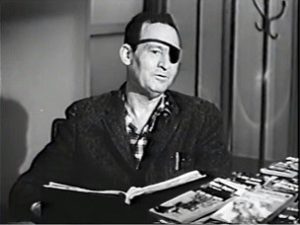
 The New Adventures of Michael Shayne (1944-53) aired “The Case of the Phantom Neighbor” on Saturday, January 8, 1949. Since this is only the 5th episode of this show we’ve run (the first in July of 2022 and the last in September of 2024, just shy of a year ago), it is time to reprise the original introduction for newcomers to this excellent detective program.
The New Adventures of Michael Shayne (1944-53) aired “The Case of the Phantom Neighbor” on Saturday, January 8, 1949. Since this is only the 5th episode of this show we’ve run (the first in July of 2022 and the last in September of 2024, just shy of a year ago), it is time to reprise the original introduction for newcomers to this excellent detective program.
The show had three different iterations and titles: Michael Shayne, Private Detective (1944-47), The New Adventures of Michael Shayne (1948-49), and from 1952 until its demise in 1953 simply The Adventures of Michael Shayne. While each show had a different lead actor playing Shayne, many will say their favorite was probably film actor Jeff Chandler (1918-1961, photo below right), who played Shayne in The New Adventures of Michael Shayne, from which this week’s episode is taken. It should be noted that due to syndication the precise first air dates for these programs are difficult to pin down, so we have used the date for this episode as given by the Old Time Radio Researchers Library.
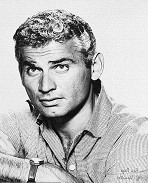 The character of Michael Shayne, Detective was the brainchild of Davis Dresser (1904-1977, photo top right) who used the pseudonym of Brett Halliday for his mystery novels. Rather prolific, he would also pen a number of westerns as well as many stories for other genre pulps using a variety of other pseudonyms, but it is the work bylined with the Brett Halliday pen name that has had the most enduring legacy of all of Dresser’s works. His first Michael Shayne novel, Dividend on Death (and first novel of any kind) was turned down by 21 publishers until Henry Holt & Co. bought and published it in 1939. Dresser would go on to write 30 Michael Shayne novels for the next 25 years or so, turning over the reins to others in 1958, leaving the series in the capable hands of the ghost writers. Some of these “ghost writers” (many quite popular in their own right as mystery novelists, or having proved themselves in other genres, including science fiction and/or fantasy) include Sam Merwin, Jr., Robert Arthur, Frank Belknap Long, and Bill Pronzini.
The character of Michael Shayne, Detective was the brainchild of Davis Dresser (1904-1977, photo top right) who used the pseudonym of Brett Halliday for his mystery novels. Rather prolific, he would also pen a number of westerns as well as many stories for other genre pulps using a variety of other pseudonyms, but it is the work bylined with the Brett Halliday pen name that has had the most enduring legacy of all of Dresser’s works. His first Michael Shayne novel, Dividend on Death (and first novel of any kind) was turned down by 21 publishers until Henry Holt & Co. bought and published it in 1939. Dresser would go on to write 30 Michael Shayne novels for the next 25 years or so, turning over the reins to others in 1958, leaving the series in the capable hands of the ghost writers. Some of these “ghost writers” (many quite popular in their own right as mystery novelists, or having proved themselves in other genres, including science fiction and/or fantasy) include Sam Merwin, Jr., Robert Arthur, Frank Belknap Long, and Bill Pronzini.
The Shayne character is of the hard-boiled detective school, and does not exhibit the highest ethical standards when it comes to catching the bad guys. Known as “the reckless, red-headed Irishman,” Shayne is no doubt derived from many of Dresser’s own life experiences. From his wikipedia page: “Dresser was born in Chicago, Illinois, but mostly grew up in West Texas. Here he lost an eye to barbed wire as a boy, and thus had to wear an eye patch for the rest of his life. At the age of 14, he ran away from home and enlisted in the U.S. 5th Cavalry Regiment at Fort Bliss, Texas, followed by a year of Border Patrol duty on the Rio Grande. After his service, he returned to Texas to finish high school. In search of adventure, Dresser traveled throughout the Southwest working at various odd jobs, including that of muleskinner, farm hand, deckhand on a freighter in the Gulf of Mexico, laborer in the California oilfields, etc. Eventually, he went to Tri-State College of Engineering, where he received a certificate in civil engineering. Back in Texas, he worked as an engineer and surveyor for several years before turning to writing in 1927.”
While Shayne’s given residence and base of operations in the novels was Miami, for the radio versions the script writers played a little fast and loose with his hometown and had him solving mysteries in Oakland and New Orleans before eventually returning to Miami. This story, for instance, has Shayne working out of New Orleans. It is also worth noting that police detective Lieutenant Lefevre is played by none other than Jack Webb, who is probably most famous for both his radio but especially TV roles as Sergeant Joe Friday on Dragnet (1951-59, 1967-70).
Dresser/Halliday was one of the founding members of the Mystery Writers of America and in 1954 he and his wife were honored with Edgar Awards for their critical work in the field. Dresser’s/Halliday’s Michael Shayne character was a multi-genre character, appearing not only in novels and on radio, but in films (7 films starring Lloyd Nolan, and 5 with Hugh Beaumont who would later star in TV’s Leave it to Beaver), a television show (1960-61), and even a comic book spinoff tie-in to the popular television show. And last but not least was the Michael Shayne Mystery Magazine, begun in 1956 and lasting for almost 30 years, which for several years was edited by Frank Belknap Long.
“The Case of the Phantom Neighbor” begins when a young woman phones Shayne at 1 AM, says she picked his name out of the phone book at random, and that she’s just killed a man. The obvious and overwhelming evidence all points to the young woman’s guilt but in some hard to pin down gut feeling something about her story doesn’t sit right with Shayne and he suspects she is innocent. Proving it is almost impossible, especially since Lieutenant LeFevre is hellbent on locking her up and throwing away the key. Digging in his heels, Shayne begins the thankless task he has set for himself of proving the woman’s innocence. It involves a thorny thicket of misdirection, lies, and false alibis that he must untangle, not to mention a slick bit of deduction that gives rise to his theory that eventually leads to solving the case. Shayne proves it’s seldom wise to dismiss a seasoned and highly respected detective’s gut feelings about a case despite an overwhelming amount of hard evidence against a client, especially one now officially filed away as “The Case of the Phantom Neighbor.”
(The linked CD at the top includes this episode and 15 others, with a Program Guide by esteemed old time radio historian, and friend of this weekly program, Karl Schadow.)
Play Time: 26:44
{This episode of Michael Shayne aired on Saturday evening, January 8th, 1949. The neighborhood gang was eager to make tracks to the nearby newsstand after church the next day, for with all the holidays now behind them all they could look forward to was their visits to the newsstand to take them away from the next few months of school without a break for a possible snow day or holiday. They were in luck and found a mixed assortment of excitement and escape to last them through the coming week (after trading their selections amongst themselves after they had been read). fantastic Adventures (1939-53) was founded by Ray Palmer as but one of his numerous publishing enterprises (not always successful) over the years. Palmer wanted fantastic Adventures to be a companion to the SF field’s first genre magazine Amazing Stories. At first it published simple, colorful, action fare but by the late 1940s (as a reliable source I use frequently states) it was filling its pages with material much like that in Amazing. fantastic Adventures featured a preponderance of outlandish cover art and seemed to have a fond affection for overly giant creatures such as the one depicted below, though it also loved to see on its covers: giant gorillas (at least twice), a giant seahorse, giant snakes or serpents, a giant dinosaur, a giant winged horse, giant leopards or tigers, and any number of giant sea creatures dripping foam as they rose from the deeps to attack anything in a boat or ship. It wobbled through an irregular schedule though it eventually was able to provide a solid monthly schedule for its readers from 1948 through the end of its run in early 1953. Popular Detective (1934-53) was a meat and potatoes detective pulp that owed much of its 19-year success to purchasing stories from many of the best detective authors the field could offer. It was a bi-monthly in 1949. Two Complete Detective Books (1939-53) was viewed in retrospect as an early precursor to the various book clubs that would come about years later, offering current, full-length detective novels at an affordable price. It began and ended as a quarterly, but from mid-1943 through early 1951 it settled into a stable bi-monthly schedule.}
[Left: fantastic Adventures, 1/49 – Center: Popular Detective, 1/49 – Right: Two Complete Detective Books, 1/49]
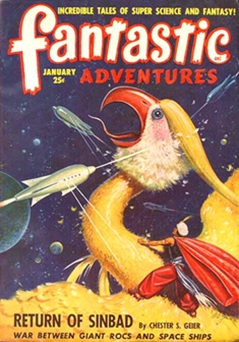
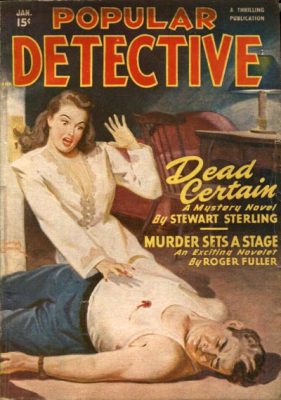
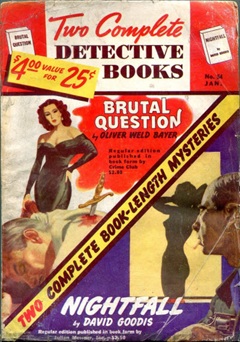
To view the entire list of weekly Old Time Radio episodes at Tangent Online, click here.